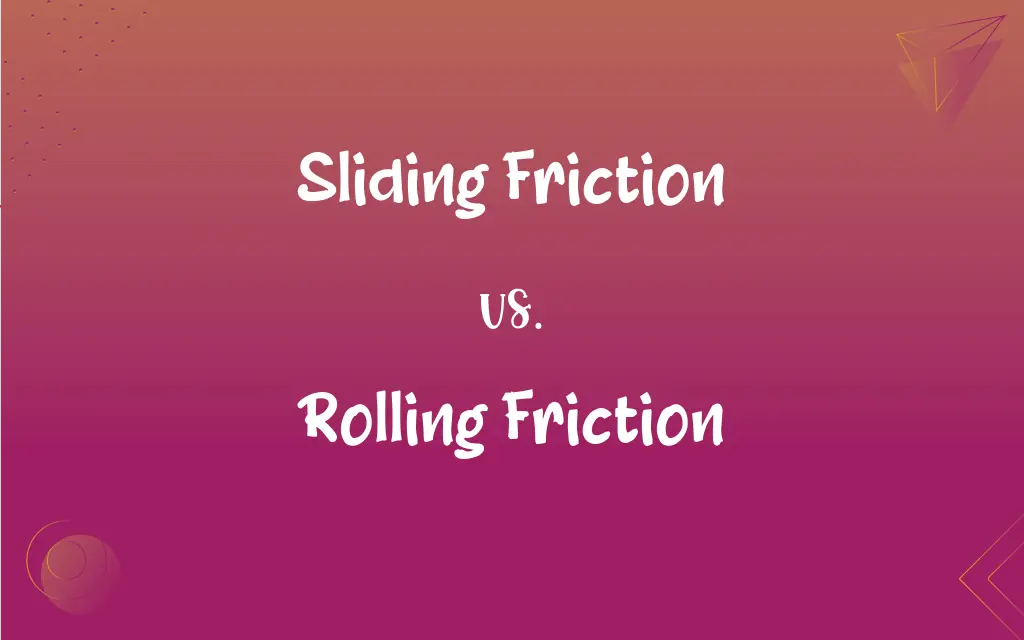Sliding Friction vs. Rolling Friction: What's the Difference?
Edited by Aimie Carlson || By Harlon Moss || Updated on October 18, 2023
Sliding friction occurs when two surfaces slide over each other, while rolling friction is resistance when an object rolls over a surface.

Key Differences
Sliding friction refers to the resistance that surfaces face when they move or slide past each other without any rolling motion. This type of friction is prevalent when there's no intervening layer, such as a lubricant or a cushion of air, between the two surfaces. Rolling friction, on the other hand, arises when an object rolls over a surface. This friction is typically less than sliding friction, given that less surface area generally comes into contact.
Sliding friction is a common phenomenon we experience in our daily lives. Whenever you drag a book across a table or push a box over the floor, you are overcoming sliding friction. The roughness of the two interacting surfaces primarily determines its magnitude. Rolling friction, in contrast, is encountered when objects like wheels, balls, or cylinders roll over a surface. It's significantly impacted by the nature of both the rolling object and the surface it's moving upon.
In terms of energy, sliding friction often results in more heat production compared to rolling friction. This is because of the continuous resistance between the entire surfaces sliding past each other. Rolling friction, due to its nature, involves less intensive contact and thus generates less heat.
One way to visualize the difference is to consider footwear. When you slide your foot on the ground (simulating sliding), you feel more resistance, representing sliding friction. But if you were to roll a shoe, the resistance you'd feel would be due to rolling friction – typically less than when sliding.
Lastly, engineers and designers often aim to reduce sliding friction in machines because it can cause wear and tear. Lubricants are commonly used to decrease it. In contrast, rolling friction is harnessed beneficially in areas like transportation, where wheels and bearings operate more efficiently due to lower resistance.
ADVERTISEMENT
Comparison Chart
Definition
Resistance between surfaces sliding past each other
Resistance when an object rolls over a surface
Occurrence
When two surfaces slide
When an object rolls
Heat Production
Typically higher
Typically lower
Surface Contact
Extensive surface contact
Limited contact points
Common Scenarios
Dragging or pushing objects
Objects with wheels or ball bearings
ADVERTISEMENT
Sliding Friction and Rolling Friction Definitions
Sliding Friction
Opposing force between objects moving laterally against each other.
Dragging furniture across the floor generates sliding friction.
Rolling Friction
The frictional force at the point where a rolling object contacts a surface.
Bowling balls experience rolling friction on the alley.
Sliding Friction
The friction encountered during the motion of one surface over another.
A child feels sliding friction when going down a slide.
Rolling Friction
The opposing force that hinders the motion of rolling objects.
Roller skates are designed to minimize rolling friction for a smoother ride.
Sliding Friction
Resistance faced by surfaces sliding against each other.
Sliding a sled over snow involves overcoming sliding friction.
Rolling Friction
Friction experienced by objects in rolling motion.
Cars utilize tires to manage and reduce the impacts of rolling friction.
Sliding Friction
The opposing force when two objects slide past one another.
Ice skaters experience reduced sliding friction due to the ice's smoothness.
Rolling Friction
Resistance generated at the contact point of a rolling object.
Ball bearings in machines help reduce rolling friction, enhancing efficiency.
Sliding Friction
Frictional force between two sliding surfaces.
Sandpaper creates high sliding friction when moved against wood.
Rolling Friction
Resistance faced when an object rolls over a surface.
Bicycles experience rolling friction as the tires move over the road.
FAQs
Which usually has a higher magnitude, sliding friction or rolling friction?
Typically, sliding friction is greater than rolling friction.
How can sliding friction be reduced?
Using lubricants or making surfaces smoother.
How does rolling friction differ?
It's the resistance when an object rolls over a surface.
Why do cars have rubber tires?
To manage and reduce the impacts of both sliding and rolling friction.
What is sliding friction?
Resistance faced by surfaces sliding against each other.
Why do ball bearings reduce rolling friction?
They minimize the contact points between surfaces, reducing resistance.
How does weight influence rolling friction?
While weight can impact it, the nature of the surfaces in contact plays a more significant role.
Why do rolling suitcases move more effortlessly than dragging them?
Rolling results in reduced friction compared to sliding.
What affects the magnitude of rolling friction?
The nature of both the rolling object and the surface it rolls upon.
Is rolling friction beneficial in any way?
Yes, it's harnessed in transportation for the efficient operation of wheels and bearings.
Is sliding friction always undesirable?
No, it's essential for activities like walking or gripping objects.
Are there situations where sliding friction is preferred over rolling?
Yes, such as in brakes where sliding friction helps stop movement.
Is rolling friction constant for all objects?
No, it varies based on the object's material and the surface it's rolling upon.
How do race cars manage sliding friction?
By using specialized tires and materials to enhance grip and control.
Is sliding friction only present in solids?
No, it can also occur in liquids and gases, though it's often termed differently.
Why do ice skaters glide smoothly?
The ice reduces sliding friction, allowing for smoother movement.
Does weight affect sliding friction?
Yes, increased weight can increase sliding friction by pressing surfaces together more firmly.
How does surface roughness impact sliding friction?
Rougher surfaces generally increase sliding friction.
Why don't wheels slide instead of roll?
Rolling minimizes friction, making movement more efficient.
Can rolling friction occur in non-round objects?
Yes, but the object would need a consistent axis of rotation and appropriate conditions for rolling.
About Author
Written by
Harlon MossHarlon is a seasoned quality moderator and accomplished content writer for Difference Wiki. An alumnus of the prestigious University of California, he earned his degree in Computer Science. Leveraging his academic background, Harlon brings a meticulous and informed perspective to his work, ensuring content accuracy and excellence.
Edited by
Aimie CarlsonAimie Carlson, holding a master's degree in English literature, is a fervent English language enthusiast. She lends her writing talents to Difference Wiki, a prominent website that specializes in comparisons, offering readers insightful analyses that both captivate and inform.































































